Pathologist Ryan Cole Discusses his Concerns about the mRNA vax with Brett Weinstein
For those who fell for the false consensus and were tricked by public health and government officials into taking the COVID vac, here at least a dozen big things to worry about. Take your pick: cancer, blood clots (including enormous elastic clots reported by funeral homes), myocarditis. There something for everyone here, especially with the recent report on the cancer risks of pseudouridine (see end of this article).
Ryan Cole is an experienced pathologist who was severely abused by the medical establishment for daring the question the narrative (that story is that last 10% of this video). You can find this video on Rumble.com at Darkhorse podcast hosted by Brett Weinstein.
--
Recent article on the cancer dangers of pseudouridine:







